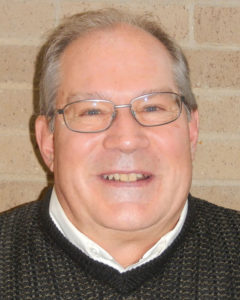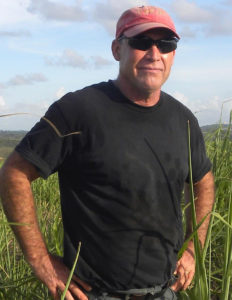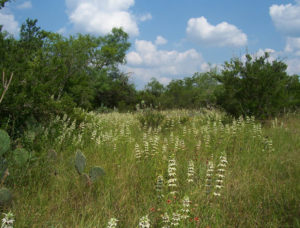Sid Kyle Endowments announced at Texas A&M
Department to intensify research on savannas in Texas, worldwide
Writer: Kay Ledbetter, 806-677-5608, [email protected]
Contact: Dr. Katy Kavanagh, 979-845-5033, [email protected]
Dr. Thomas Boutton, 979-845-8027, [email protected]
Dr. Bradford Wilcox, 979-458-1899, [email protected]

COLLEGE STATION – Designation of two endowed positions in the Texas A&M University department of ecosystem science and management are the cornerstone for a new savanna research initiative.
Dr. Tom Boutton, Regents Professor and Texas A&M AgriLife Senior Faculty Fellow in the department, has been awarded the Sid Kyle Endowed Chair in Arid and Semi-Arid Land Biogeochemistry.
Dr. Bradford Wilcox, professor and ecohydrologist in the same department, has been awarded the Sid Kyle Endowed Professor in Semi-Arid and Arid Land Ecohydrology.
These awards were made possible thanks to a generous gift from the estate of Sid and Catherine Kyle, said Dr. Kathleen Kavanagh, department head.

Kavanagh said the creation of the endowed positions is just the first step in strengthening the department’s commitment to savanna research.
“Because savanna ecosystems cover about 20 percent of the land mass of the globe and about 50 percent of Texas, we’ve decided this is an area that we have expertise in and we want to develop it further,” Kavanagh said.
Savannas in Texas were once strongly grass-dominated, but have been experiencing woody plant encroachment during the past century due to livestock grazing, fire suppression and other human activities. Mesquite and juniper species are generally the woody plants that are increasing in Texas savannas and other portions of the southwestern U.S., the researchers said.
“The more we understand about the science of these ecosystems, the more we will be able to manage them in ways that are beneficial to humans,” Boutton said.
Kavanagh said the change to the relative abundance of grass and woody plants in a savanna can be both beneficial and negative.
“It’s just a different environment, and we need to know how best to adapt to it and thrive in it,” she said. “There are a lot of positives from the wildlife side of things, but not so much on the cattle side if the grass is replaced by too many woody plants. There are tradeoffs. It takes more investment by ranchers to control the brush and it affects productivity.”

Kavanagh said they will work collaboratively with multiple universities, both internationally and nationally, and with Texas A&M AgriLife Research to explore all aspects of the causes and impacts of a shift in the abundance of woody plants since this is a global issue.
“We are increasing our concentration of resources in this area, and these endowed positions are indicative of the level of expertise we have and the investment we are making,” she said. “We see these as the cornerstone of the savanna research initiative.”
Boutton said an important aspect of this research is identifying the changes in the way the ecosystem is operating, “which will help us develop better methodologies to manage woody plant encroachment.”

For instance, woody plant encroachment into arid and semiarid environments has been identified as the second largest carbon sink in North America, suggesting this phenomenon is an important component of the carbon cycle and may have implications for the climate system. In addition, increased woody plant abundance in grasslands and savannas could have implications for the water cycle and the occurrence of wildfires.
Wilcox said it makes sense to help landowners begin managing these landscapes as savannas now, because they are not likely to go back to grasslands.
For instance, he said, Texas is much more prone to wildfire because of the transition from grasslands to savannas with more woody plants, and that should influence how people manage their land.
“Many people are not aware of the changes and haven’t changed management practices,” Wilcox said. “When you have drought years, these landscapes are set up for large fires. They are often big and catastrophic.”
There has also been a shift in landowners, he said.
“There are more, smaller properties with amenity landowners who don’t depend on the landscape for their livelihood, and they have different motivations in their management,” Wilcox said.
Moving forward, the researchers said they will continue to concentrate on understanding what the implications of the shift in landscape are from a social, economic, hydrological and ecological dimension.
Boutton said he expects to use the $50,000 per year from his endowment to sustain ongoing research in carbon nitrogen and phosphorus cycling in grasslands and savannas.
Most of his work has been centered at the department’s La Copita Demonstration Ranch and Research Area in Jim Wells County west of Corpus Christi.
“At that site I’ve been looking at the impact of woody plant encroachment on carbon nitrogen and phosphorus cycling,” Boutton said. “It used to be open grassland and is now being invaded by subtropical thorn woodlands.”
He said in the future he would like to expand his studies to look at the same type of phenomenon at the Texas A&M AgriLife Research Station – Sonora, where oak savanna has been invaded by juniper.
Wilcox said he intends to put his $25,000 a year into greater support of his graduate students with their field research.
“I would also like to start making some baseline ecohydrology measurements on the department’s 80-acre Ecology and Natural Resources Teaching Area next to the Bryan/College Station airport where there’s native post oak savanna,” he said.
His research would include monitoring rainfall, runoff, soil and water and having the studies maintained by undergraduate students and mentored by graduate students.
Additionally, Wilcox said, he will be working on semi-arid savannas and trying to understand the ecohydrological interactions in these landscapes or consequences of woody plant encroachment at the La Copita site as well as in the shrublands of northeastern Brazil and Sonora, Mexico.


